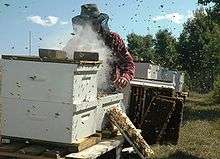Housefly
| Housefly | |
|---|---|
 | |
Not evaluated (IUCN 3.1) | |
| Scientific classification | |
| Kingdom: | Animalia |
| Phylum: | Arthropoda |
| Class: | Insecta |
| Order: | Diptera |
| Section: | Schizophora |
| Family: | Muscidae |
| Genus: | Musca |
| Species: | M. domestica |
| Binomial name | |
| Musca domestica | |
| Subspecies | |
The housefly (Musca domestica) is a fly of the suborder Cyclorrhapha. It is believed to have evolved in the Cenozoic era, possibly in the Middle East, and has spread all over the world as a commensal of humans. It is the most common fly species found in houses. Adults are grey to black, with four dark, longitudinal lines on the thorax, slightly hairy bodies, and a single pair of membranous wings. They have red eyes, set farther apart in the slightly larger female.
The female housefly usually mates only once and stores the sperm for later use. She lays batches of about 100 eggs on decaying organic matter such as food waste, carrion, or faeces. These soon hatch into legless white larvae, known as maggots. After 2 to 5 days of development, these metamorphose into reddish-brown pupae, about 8 mm (0.3 in) long. Adult flies normally live for 2 to 4 weeks, but can hibernate during the winter. The adults feed on a variety of liquid or semiliquid substances, as well as solid materials which have been softened by their saliva. They can carry pathogens on their bodies and in their faeces, contaminate food, and contribute to the transfer of food-borne illnesses, while, in numbers, they can be physically annoying. For these reasons, they are considered pests.
Houseflies have been used in the laboratory in research into ageing and sex determination. Flies appear in literature from Ancient Greek myth and Aesop's The Impertinent Insect onwards. Authors sometimes choose the fly to speak of the brevity of life, as in William Blake's 1794 poem "The Fly", which deals with mortality subject to uncontrollable circumstances.
Description
.jpg)
Adult houseflies are usually 6 to 7 mm (0.24 to 0.28 in) long with a wingspan of 13 to 15 mm (0.5 to 0.6 in). The females tend to be larger winged than males, while males have relatively longer legs. Females tend to vary more in size[1] and there is geographic variation with larger individuals in higher latitudes.[2] The head is strongly convex in front and flat and slightly conical behind. The pair of large compound eyes almost touch in the male, but are more widely separated in the female. They have three simple eyes (ocelli) and a pair of short antennae.[3] Flies process visual information around seven times more quickly than humans, enabling them to identify and avoid attempts to catch or swat them, since they effectively see the human's movements in slow motion with their higher flicker fusion rate.[4][5]
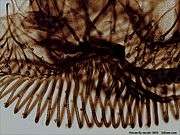
The mouthparts are specially adapted for a liquid diet; the mandibles and maxillae are reduced and not functional, and the other mouthparts form a retractable, flexible proboscis with an enlarged, fleshy tip, the labellum. This is a sponge-like structure that is characterised by many grooves, called pseudotracheae, which suck up fluids by capillary action.[6][7] It is also used to distribute saliva to soften solid foods or collect loose particles.[8] Houseflies have chemoreceptors, organs of taste, on the tarsi of their legs, so they can identify foods such as sugars by walking over them.[9] Flies are often seen cleaning their legs by rubbing them together, enabling the chemoreceptors to taste afresh whatever they walk on next.[10] At the end of each leg is a pair of claws, and below them are two adhesive pads, pulvilli, enabling the fly to walk up smooth walls and ceilings using Van der Waals forces. The claws help the fly to unstick the foot for the next step. Flies walk with a common gait on horizontal and vertical surfaces with three legs in contact with the surface and three in movement. On inverted surfaces, they alter the gait to keep four feet stuck to the surface.[11] Flies land on a ceiling by flying straight towards it; just before landing, they make a half roll and point all six legs at the surface, absorbing the shock with the front legs and sticking a moment later with the other four, also.[12]
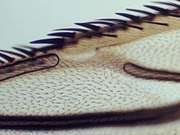
The thorax is a shade of gray, sometimes even black, with four dark, longitudinal bands of even width on the dorsal surface. The whole body is covered with short hairs. Like other Diptera, houseflies have only one pair of wings; what would be the hind pair is reduced to small halteres that aid in flight stability. The wings are translucent with a yellowish tinge at their base. Characteristically, the medial vein (M1+2 or fourth long vein) shows a sharp upward bend. Each wing has a lobe at the back, the calypter, covering the haltere. The abdomen is gray or yellowish with a dark stripe and irregular dark markings at the side. It has 10 segments which bear spiracles for respiration. In males, the ninth segment bears a pair of claspers for copulation, and the 10th bears anal cerci in both sexes.[3][13]

A variety of species around the world appear similar to the housefly, such as the lesser house fly, Fannia canicularis; the stable fly, Stomoxys calcitrans;[13] and other members of the genus Musca such as M. vetustissima, the Australian bush fly and several closely related taxa that include M. primitiva, M. shanghaiensis, M. violacea, and M. varensis.[14] The systematic identification of species may require the use of region-specific taxonomic keys and can require dissections of the male reproductive parts for confirmation.[15][16]
Distribution
The housefly is probably the insect with the widest distribution in the world; it is largely associated with humans and has accompanied them around the globe. It is present in the Arctic Circle, as well as in the tropics, where it is abundant. It is present in all populated parts of Europe, Asia, Australasia, and the Americas.[3]
Evolution and taxonomy
Though the order of flies (Diptera) is much older, true houseflies are believed to have evolved in the beginning of the Cenozoic era.[17] The housefly's superfamily, Muscoidea, is most closely related to the Oestroidea (blow flies and allies), and more distantly to the Hippoboscoidea (louse flies and allies). They are thought to have originated in the southern Palearctic region, particularly the Middle East. Because of their close, commensal relationship with humans, they probably owe their worldwide dispersal to co-migration with humans.[18]
The housefly was first described as Musca domestica in 1758 based on the common European specimens by the Swedish botanist and zoologist Carl Linnaeus in his Systema naturae, and continues to be classified under that name.[19] A more detailed description was given in 1776 by the Danish entomologist Johan Christian Fabricius in his Genera Insectorum.[3]
|
| ||||||||||||||||||||||||||||||||||||||||||||||||||||||||||||||||||||||||||||||
| Cladogram showing higher level classification[20][21][22] and position of Musca within the family Muscidae based on Couri and Carvalho 2003.[23] |
Life cycle
.jpg)
Each female housefly can lay up to 500 eggs in a lifetime, in several batches of about 75 to 150. The eggs are white and are about 1.2 mm (0.05 in) in length, and they are deposited by the fly in a suitable place, usually dead and decaying organic matter, such as food waste, carrion, or faeces. Within a day, larvae (maggots) hatch from the eggs; they live and feed where they were laid. They are pale-whitish, 3 to 9 mm (0.12 to 0.35 in) long, thinner at the mouth end, and legless.[13] Larval development takes from two weeks, under optimal conditions, to 30 days or more in cooler conditions. The larvae avoid light; the interiors of heaps of animal manure provide nutrient-rich sites and ideal growing conditions, warm, moist, and dark.[13]
._Coloured_Wellcome_V0022571.jpg)
At the end of their fourth instar, the larvae crawl to a dry, cool place and transform into pupae. The pupal case is cylindrical with rounded ends, about 1.2 mm (0.05 in) long, and formed from the last shed larval skin. It is yellowish at first, darkening through red and brown to nearly black as it ages. Pupae complete their development in from two to six days at 35 °C (95 °F), but may take 20 days or more at 14 °C (57 °F).[13]
When metamorphosis is complete, the adult fly emerges from the pupa. To do this, it uses the ptilinum, an eversible pouch on its head, to tear open the end of the pupal case. The adult housefly lives from two weeks to a month in the wild, or longer in benign laboratory conditions. Having emerged from the pupa, it ceases to grow; a small fly is not necessarily a young fly, but is instead the result of getting insufficient food during the larval stage.[13]
Male houseflies are sexually mature after 16 hours and females after 24. Females produce a pheromone, (Z)-9-tricosene (muscalure). This cuticular hydrocarbon is not released into the air and males sense it only on contact with females;[12] it has found use as in pest control, for luring males to fly traps.[24][25] The male initiates the mating by bumping into the female, in the air or on the ground, known as a "strike". He climbs on to her thorax, and if she is receptive, a courtship period follows, in which the female vibrates her wings and the male strokes her head. The male then reverses onto her abdomen and the female pushes her ovipositor into his genital opening; copulation, with sperm transfer, lasts for several minutes. Females normally mate only once and then reject further advances from males, while males mate multiple times.[26] A volatile semiochemical that is deposited by females on their eggs attracts other gravid females and leads to clustered egg deposition.[27]
The larvae depend on warmth and sufficient moisture to develop; generally, the warmer the temperature, the faster they grow. In general, fresh swine and chicken manures present the best conditions for the developing larvae, reducing the larval period and increasing the size of the pupae. Cattle, goat, and horse manures produce fewer, smaller pupae, while fully composted swine manure, with a water content under 40%, produces none at all.[28] Pupae can range from about 8.0 to 20 milligrams (0.0003 to 0.0007 ounces) under different conditions.[29]
The lifecycle can be completed in seven to 10 days under optimal conditions, but may take up to two months in adverse circumstances. In temperate regions, 12 generations may occur per year, and in the tropics and subtropics, more than 20.[13]
Ecology

Houseflies play an important ecological role in breaking down and recycling organic matter. Adults are mainly carnivorous; their primary food is animal matter, carrion, and faeces, but they also consume milk, sugary substances, and rotting fruit and vegetables. Solid foods are softened with saliva before being sucked up.[7] They can be opportunistic blood feeders.[30] Houseflies have a mutualistic relationship with the bacterium Klebsiella oxytoca, which can live on the surface of housefly eggs and deter fungi which compete with the fly larvae for nutrients.[31]
Adult houseflies are diurnal and rest at night. If inside a building after dark, they tend to congregate on ceilings, beams, and overhead wires, while out of doors, they crawl into foliage or long grass, or rest in shrubs and trees or on wires.[13] In cooler climates, some houseflies hibernate in winter, choosing to do so in cracks and crevices, gaps in woodwork, and the folds of curtains. They arouse in the spring when the weather warms up, and search out a place to lay their eggs.[32]
Houseflies have many predators, including birds, reptiles, amphibians, various insects, and spiders. The eggs, larvae, and pupae have many species of stage-specific parasites and parasitoids. Some of the more important are the parasitic wasps Muscidifurax uniraptor and Spalangia cameroni; these lay their eggs in the fly larvae tissue and their offspring complete their development before the adult flies can emerge from the pupae.[13] Hister beetles feed on housefly larvae in manure heaps and the predatory mite Macrocheles muscae domesticae consumes housefly eggs, each mite eating 20 eggs per day.[33]
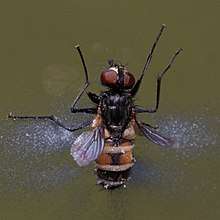
Houseflies sometimes carry phoretic (nonparasitic) passengers including mites such as Macrocheles muscaedomesticae,[34] and the pseudoscorpion Lamprochernes chyzeri.[35]
The pathogenic fungus Entomophthora muscae causes a fatal disease in houseflies. After infection, the fungal hyphae grow throughout the body, killing the fly in about 5 days. Infected flies have been known to seek high temperatures that could suppress the growth of the fungus. Affected females tend to be more attractive to males, but the fungus-host interactions have not been fully understood.[36] The housefly also acts as the alternative host to the parasitic nematode Habronema muscae that attacks horses.[37]
Relationship with humans
Flies are a nuisance, disturbing people at leisure and at work, but they are disliked principally because of their habits of contaminating foodstuffs. They alternate between breeding and feeding in dirty places with feeding on human foods, during which process they soften the food with saliva and deposit their faeces, creating a health hazard.[38] However, fly larvae are as nutritious as fish meal, and could be used to convert waste to feed for fish and livestock.[39]
Flies have been used in art and artefacts in many cultures. In 16th- and 17th-century European vanitas paintings, flies sometimes occur as memento mori. They may also be used for other effects as in the Flemish painting, the Master of Frankfurt (1496). Fly amulets were popular in ancient Egypt.[40][41]
As a disease vector
.jpg)
Houseflies can fly for several miles from their breeding places,[42] carrying a wide variety of organisms on their hairs, mouthparts, vomitus, and faeces. Parasites carried include cysts of protozoa, e.g. Entamoeba histolytica and Giardia lamblia and eggs of helminths, e.g., Ascaris lumbricoides, Trichuris trichiura, Hymenolepis nana, and Enterobius vermicularis.[43] Houseflies do not serve as a secondary host or act as a reservoir of any bacteria of medical or veterinary importance, but they do serve as mechanical vectors to over 100 pathogens, such as those causing typhoid, cholera, salmonellosis,[44] bacillary dysentery,[45] tuberculosis, anthrax, ophthalmia,[46] and pyogenic cocci, making them especially problematic in hospitals and during outbreaks of certain diseases.[43] Disease-causing organisms on the outer surface of the fly may survive for a few hours, but those in the crop or gut can be viable for several days.[38] Usually, too few bacteria are on the external surface of the flies (except perhaps for Shigella) to cause infection, so the main routes to human infection are through the fly's regurgitation and defecation.[47]
In the early 20th century, Canadian public health workers believed that the control of flies was important in controlling the spread of tuberculosis. A "swat that fly" contest was held for children in Montreal in 1912.[48] Flies were targeted in 1916, when a polio epidemic broke out in the eastern United States. The belief that fly control was key to disease control continued, with extensive use of insecticidal spraying, well until the mid 1950s, declining only after the introduction of Salk's vaccine.[49] In China, Mao Zedong's Four Pests Campaign between 1958 and 1962 exhorted the people to catch and kill flies, along with rats, mosquitoes, and sparrows.[50]
In warfare

During the Second World War, the Japanese worked on entomological warfare techniques under Shirō Ishii. Japanese Yagi bombs developed at Pingfan consisted of two compartments, one with houseflies and another with a bacterial slurry that coated the flies prior to release. Vibrio cholerae, which causes cholera, was the bacterium of choice, and was used in China in Baoshan in 1942, and in northern Shandong in 1943. Baoshan had been used by the Allies and bombing produced epidemics that killed 60,000 people in the initial stages reaching a radius of 200 km, which finally took a toll of 200,000 victims. The Shandong attack killed 210,000; the occupying Japanese troops had been vaccinated in advance.[51]
In waste management
The ability of housefly larvae to feed and develop in a wide range of decaying organic matter is important for recycling of nutrients in nature. This could be exploited to combat ever-increasing amounts of waste.[52] Housefly larvae can be mass-reared in a controlled manner in animal manure, reducing the bulk of waste and minimizing environmental risks of its disposal.[53][54] Harvested maggots may be used as feed for animal nutrition.[54][55]
Control
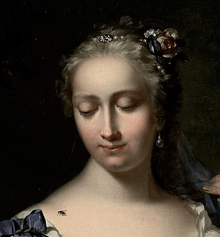
Flies can be controlled, at least to some extent, by physical, chemical, or biological means. Physical controls include screening with small mesh or the use of vertical strips of plastic or strings of beads in doorways to prevent entry of flies into buildings. Fans to create air movement or air barriers in doorways can deter flies from entering, and food premises often use ultraviolet light traps that electrocute insects. Sticky fly papers hanging from the ceiling can also be effective.[47] Another approach is the elimination as far as possible of potential breeding sites. Keeping garbage in lidded containers and collecting it regularly and frequently, prevents any eggs laid from developing into adults. Unhygienic rubbish tips are a prime fly-breeding site, but if garbage is covered by a layer of soil, preferably daily, this can be avoided.[47]
Insecticides can be used. Larvicides kill the developing larvae, but large quantities may need to be used to reach areas below the surface. Aerosols can be used in buildings to "zap" flies, but outside applications are only temporarily effective. Residual sprays on walls or resting sites have a longer-lasting effect.[47] Many strains of housefly have become immune to the most commonly used insecticides.[56][57]
Several means of biological pest control have been investigated. These include the introduction of another species, the black soldier fly (Hermetia illucens), whose larvae compete with those of the housefly for resources.[58] The introduction of dung beetles to churn up the surface of a manure heap and render it unsuitable for breeding is another approach.[58] Augmentative biological control by releasing parasitoids can be used, but flies breed so fast that the natural enemies are unable to keep up.[59]
In science
The ease of culturing houseflies, and the relative ease of handling them when compared to the fruit fly Drosophila, have made them useful as model organism for use in laboratories. The American entomologist Vincent Dethier, in his humorous To Know A Fly (1962), pointed out that as a laboratory animal, houseflies did not trouble anyone sensitive to animal cruelty. Houseflies have a small number of chromosomes, haploid six or diploid 12.[60] Because the somatic tissue of the housefly consists of long-lived postmitotic cells, it can be used as an informative model system for understanding cumulative age-related cellular alterations. Oxidative DNA damage 8-hydroxydeoxyguanosine in houseflies was found in one study to increase with age and reduce life expectancy supporting the hypothesis that oxidative molecular damage is a causal factor in senescence (aging).[61][62][63]
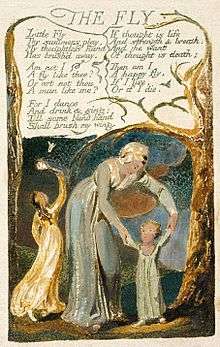
The housefly is an object of biological research, partly for its variable sex-determination mechanism. Although a wide variety of sex-determination mechanisms exists in nature (e.g. male and female heterogamy, haplodiploidy, environmental factors), the way sex is determined is usually fixed within a species. The housefly is, however, thought to exhibit multiple mechanisms for sex determination, such as male heterogamy (like most insects and mammals), female heterogamy (like birds), and maternal control over offspring sex. The exact mechanism of sex determination involved is unresolved,[64] but sexual differentiation is controlled as in other insects by an ancient developmental switch, doublesex, which is regulated by the transformer protein in many different insects.[65] The antimicrobial peptides produced by housefly maggots are of pharmacological interest.[66]
In the 1970s, the aircraft modeller Frank Ehling constructed miniature balsa-wood aircraft powered by live houseflies.[67] Studies of tethered flies have helped in the understanding of insect vision, sensory perception, and flight control.[68]
In literature
The Impertinent Insect is a group of five fables, sometimes ascribed to Aesop, concerning an insect, in one version a fly, which puffs itself up to seem important. In the Biblical fourth plague of Egypt, flies represent death and decay, while the Philistine god Beelzebub's name may mean "lord of the flies".[69] In Greek mythology, Myiagros was a god who chased away flies during the sacrifices to Zeus and Athena; Zeus sent a fly to bite Pegasus, causing Bellerophon to fall back to Earth when he attempted to ride the winged steed to Mount Olympus.[70] In the traditional Navajo religion, Big Fly is an important spirit being.[71][72][73]
William Blake's 1794 poem "The Fly", part of his collection Songs of Experience, deals with the insect's mortality, subject to uncontrollable circumstances, just like humans.[74] Emily Dickinson's 1855 poem "I Heard a Fly Buzz When I Died" speaks of flies in the context of death.[75] In William Golding's 1954 novel Lord of the Flies, the fly is however a symbol of the children involved.[76]
Ogden Nash's humorous two-line 1942 poem "God in His wisdom made the fly/And then forgot to tell us why." indicates the debate about the value of biodiversity, given that even those considered by humans as pests have their place in the world's ecosystems.[77]
References
- ↑ Bryant, Edwin H (1977). "Morphometric Adaptation of the Housefly, Musca Domestica L., in the United States". Evolution. 31 (3): 580–596. doi:10.1111/j.1558-5646.1977.tb01046.x. PMID 28563484.
- ↑ Alves, Sueli María; Bélo, Muracy (August 2002). "Morphometric variations in the housefly, Musca domestica (L.) with latitude". Genetica. 115 (3): 243–251. doi:10.1023/a:1020685727460. ISSN 0016-6707. PMID 12440563.
- 1 2 3 4 Hewitt, C. Gordon (2011). The House-Fly: Musca Domestica Linn: Its Structure, Habits, Development, Relation to Disease and Control. Cambridge University Press. pp. 5–6. ISBN 978-0-521-23299-9.
- ↑ Johnston, Ian (15 September 2013). "Q. Why is it so hard to swat a housefly? A. It sees you coming in slow motion". The Independent. Retrieved 4 December 2017.
- ↑ Healy, Kevin; McNally, Luke; Ruxton, Graeme D.; Cooper, Natalie; Jackson, Andrew L. (2013). "Metabolic rate and body size are linked with perception of temporal information". Animal Behaviour. 86 (4): 685–696. doi:10.1016/j.anbehav.2013.06.018. PMC 3791410. PMID 24109147.
- ↑ Gullan, P. J.; Cranston, P. S. (2010). The Insects: An Outline of Entomology (4th ed.). Wiley. pp. 41, 519. ISBN 978-1-118-84615-5.
- 1 2 Mehlhorn, Heinz (2001). Encyclopedic Reference of Parasitology: Biology, Structure, Function. Springer Science & Business Media. p. 310. ISBN 978-3-540-66819-0.
- ↑ Dessì, Giancarlo (8 January 2017). "Morphology and anatomy of adults: Mouthparts". Flies. Retrieved 27 September 2017.
- ↑ Deonier, C. C.; Richardson, C. H. (1935). "The Tarsal Chemoreceptor Response of the Housefly, Musca Domestica L., to Sucrose and Levulose". Annals of the Entomological Society of America. 28 (4): 467–474. doi:10.1093/aesa/28.4.467.
- ↑ Ray, C. Claiborne (17 December 2002). "Q&A; Gleeful Flies?". The New York Times. Retrieved 4 December 2017.
- ↑ Gorb, Stanislav N. (2005). "Uncovering Insect Stickiness: Structure and Properties of Hairy Attachment Devices". American Entomologist. 51 (1): 35. doi:10.1093/ae/51.1.31.
- 1 2 Dahlem, Gregory A. (2009). "House Fly (Musca domestica)". In Resh, Vincent H.; Carde, Ring T. Encyclopedia of Insects (2 ed.). Elsevier. pp. 469–470.
- 1 2 3 4 5 6 7 8 9 Sanchez-Arroyo, Hussein; Capinera, John L. (20 April 2017). "House fly: Musca domestica". Featured Creatures. Retrieved 20 September 2017.
- ↑ West (1951):161-167.
- ↑ Paterson, H. E (2009). "The Musca domestica complex in Sri Lanka". Journal of Entomology Series B, Taxonomy. 43 (2): 247. doi:10.1111/j.1365-3113.1975.tb00134.x.
- ↑ Tumrasvin, Watanasak; Shinonaga, Satoshi (1977). "Report of Species Belonging to the Genus Musca Linné, Including the Taxonomic Key (Diptera: Muscidae)" (PDF). Bull. Tokyo Med. Dent. Univ. 24: 209–218.
- ↑ Wiegmann, B.M.; Yeates, DK; Thorne, JL; Kishino, H (December 2003). "Time flies, a new molecular time-scale for brachyceran fly evolution without a clock". Systematic Biology. 52 (6): 745–56. doi:10.1093/sysbio/52.6.745. PMID 14668115.
- ↑ Marquez, J. G.; Krafsur, E. S. (July 2002), "Gene Flow Among Geographically Diverse Housefly Populations (Musca domestica L.): A Worldwide Survey of Mitochondrial Diversity", Journal of Heredity, 93 (4): 254–259, doi:10.1093/jhered/93.4.254
- ↑ Pont, A. C. (1981). "The Linnaean species of the families Fanniidae, Anthomyiidae and Muscidae (Insecta: Diptera)". Biological Journal of the Linnean Society. 15 (2): 165–175. doi:10.1111/j.1095-8312.1981.tb00756.x.
- ↑ Wiegmann, B. M.; Trautwein, M. D.; Winkler, I. S.; Barr, N. B.; Kim, J.-W.; Lambkin, C.; Bertone, M. A.; Cassel, B. K.; et al. (2011). "Episodic radiations in the fly tree of life". PNAS. 108 (14): 5690–5695. Bibcode:2011PNAS..108.5690W. doi:10.1073/pnas.1012675108. PMC 3078341. PMID 21402926.
- ↑ Yeates, David K.; Meier, Rudolf; Wiegmann, Brian. "Phylogeny of True Flies (Diptera): A 250 Million Year Old Success Story in Terrestrial Diversification". Flytree. Retrieved 24 May 2016.
- ↑ "FLYTREE". Illinois Natural History Survey. Retrieved 22 July 2016.
- ↑ Couri, M. S.; Carvalho, C. J. B. (May 2003). "Systematic relations among Philornis Meinert, Passeromyia Rodhain & Villeneuve and allied genera (Diptera, Muscidae)". Brazilian Journal of Biology. 63 (2): 223. doi:10.1590/S1519-69842003000200007.
- ↑ Thom, C.; Gilley, D.; Hooper, J.; Esch, H. (2007). "The scent of the waggle dance". PLoS Biology. 5 (9): e228. doi:10.1371/journal.pbio.0050228. PMC 1994260. PMID 17713987.
- ↑ "(Z)-9-Tricosene (103201) Fact Sheet" (PDF). United States Environmental Protection Agency. Retrieved 8 December 2017.
- ↑ Murvosh, C.M.; Fye, R.L.; LaBrecque, G.C. (1964). "Studies on the mating behavior of the house fly, Musca domestica L." Ohio Journal of Science. 64 (4): 264–271.
- ↑ Jiang, Yong; Lei, Chao-liang; Niu, Chang-ying; Fang, Yu-ling; Xiao, Chun; Zhang, Zhong-ning (October 2002). "Semiochemicals from ovaries of gravid females attract ovipositing female houseflies, Musca domestica" (PDF). Journal of Insect Physiology. 48 (10): 945–950. doi:10.1016/s0022-1910(02)00162-2. ISSN 1879-1611. PMID 12770041.
- ↑ Breitwart; et al. (2008). "Favorability of conditions in the reproduction and development of the common housefly: a controlled study". International Journal of Entomology. 21 (11): 157–181.
- ↑ Larraín, Patricia; Salas, Claudio; Salas F (2008). "House fly (Musca domestica L.) (Diptera: Muscidae) development in different types of manure [Desarrollo de la Mosca Doméstica (Musca domestica L.) (Díptera: Muscidae) en Distintos Tipos de Estiércol]". Chilean Journal of Agricultural Research. 68 (2): 192–197. doi:10.4067/S0718-58392008000200009. ISSN 0718-5839.
- ↑ West (1951):189.
- ↑ Lam, Kevin; Thu, Kelsie; Tsang, Michelle; Moore, Margo; Gries, Gerhard (2009). "Bacteria on housefly eggs, Musca domestica, suppress fungal growth in chicken manure through nutrient depletion or antifungal metabolites". Naturwissenschaften. 96 (9): 1127–1132. Bibcode:2009NW.....96.1127L. doi:10.1007/s00114-009-0574-1.
- ↑ "Where do flies go in winter?". BBC Earth. 10 February 2015. Retrieved 23 September 2017.
- ↑ "House flies". Cornell University: Department of Entomology. 2017. Retrieved 23 September 2017.
- ↑ Ho, T. M. (1990). "Phoretic association between Macrocheles muscaedomesticae (Acari: Macrochelidae) and flies inhabiting poultry manure in Peninsular Malaysia". Experimental & Applied Acarology. 10 (1): 61–68. doi:10.1007/BF01193974.
- ↑ Christophoryova, Jana; Stloukal, Eduard; Stloukalova, Viera (2011). "First record of phoresy of pseudoscorpion Lamprochernes chyszeri in Slovakia (Pseudoscorpiones: Chernetidae)" (PDF). Folia faunistica Slovaca. 16 (3): 139–142.
- ↑ Roy, H. E.; Steinkraus, D. C.; Eilenberg, J.; Hajek, A. E.; Pell, J. K. (2006). "Bizarre Interactions and Endgames: Entomopathogenic Fungi and Their Arthropod Hosts" (PDF). Annual Review of Entomology. 51: 331–57. doi:10.1146/annurev.ento.51.110104.150941. PMID 16332215.
- ↑ Hewitt, C. Gordon (2011). The House-Fly: Musca Domestica Linn: Its Structure, Habits, Development, Relation to Disease and Control. Cambridge University Press. pp. 181–184. ISBN 978-0-521-23299-9.
- 1 2 "Houseflies" (PDF). World Health Organization. Retrieved 25 September 2017.
- ↑ Qiu, Xinghui; Hussein, Mahmoud; Pillai, Viju V.; Goddard, Joshua M.; Park, Hui G.; Kothapalli, Kumar S.; Ross, Deborah A.; Ketterings, Quirine M.; Brenna, J. Thomas; Milstein, Mark B.; Marquis, Helene; Johnson, Patricia A.; Nyrop, Jan P.; Selvaraj, Vimal (2017). "Sustainable production of housefly (Musca domestica) larvae as a protein-rich feed ingredient by utilizing cattle manure". PLOS ONE. 12 (2): e0171708. Bibcode:2017PLoSO..1271708H. doi:10.1371/journal.pone.0171708. PMC 5295707. PMID 28170420.
- ↑ Connor, Steven (2006). Fly. Reaktion Books. pp. 20, 27. ISBN 978-1861892942.
- ↑ "Fly Pendants and Cylindrical and Spherical Beads, ca. 1539–1292 B.C.E. Gold, lapis lazuli, Length: 9 11/16 in. (24.6 cm). Brooklyn Museum, Charles Edwin Wilbour Fund, 08.480.198". Retrieved 8 December 2017.
- ↑ Nazni, W.A.; Luke, H.; Wan Rozita, W.M.; Abdullah, A.G.; Sadiyah, I.; Azahari, A.H.; Zamree, I.; Tan, S.B.; Lee H.L.; Sofian A.M. (2005). "Determination of the flight range and dispersal of the house fly, Musca domestica (L.) using mark release recapture technique". Tropical Biomedicine. 22 (1): 53–61. PMID 16880754.
- 1 2 Szalanski, A.L.; Owens, C.B.; Mckay, T.; Steelman, C.D. (2004). "Detection of Campylobacter and Escherichia coli O157:H7 from filth flies by polymerase chain reaction". Medical and Entomology. 18 (3): 241–246. doi:10.1111/j.0269-283X.2004.00502.x. PMID 15347391.
- ↑ Ostrolenk, M.; Welch H. (1942). "The house fly as a vector of food poisoning organisms in food producing establishments". American Journal of Public Health. 32 (5): 487–494. doi:10.2105/ajph.32.5.487. PMC 1526899.
- ↑ Levine, O.S.; Levine M.M. (1991). "House flies (Muscadomestica) as mechanical vectors of shigellosis". Reviews of Infectious Diseases. 13 (4): 688–696. doi:10.1093/clinids/13.4.688. PMID 1925289.
- ↑ Förster, M.; Klimpel, S.; Sievert, K. (2009). "The house fly (Musca domestica) as a potential vector of metazoan parazites caught in a pig-pen in Germany". Veterinary Parasitology. 160 (1–2): 163–167. doi:10.1016/j.vetpar.2008.10.087. PMID 19081196.
- 1 2 3 4 Service, Mike (2008). Medical Entomology for Students. Cambridge University Press. pp. 140–141. ISBN 978-0-521-70928-6.
- ↑ Minnett, V.; Poutanen, M. (2007). "Swatting Flies for Health:Children and Tuberculosis in Early Twentieth-Century Montreal" (PDF). Urban History Review. 36 (1): 32–44. doi:10.7202/1015818ar.
- ↑ Cirillo, Vincent J. (2016). ""I Am the Baby Killer!" House Flies and the Spread of Polio". American Entomologist. 62 (2): 83. doi:10.1093/ae/tmw039.
- ↑ "Eliminate the Four Pests (1958)". chineseposters.net. Retrieved 7 December 2017.
- ↑ Lockwood, Jeffrey A. (2012). "Insects as Weapons of War, Terror, and Torture". Annual Review of Entomology. 57: 205–227. doi:10.1146/annurev-ento-120710-100618. PMID 21910635.
- ↑ Miller, B.F.; Teotia, J.S.; Thatcher, T.O. (1974). "Digestion of poultry manure by Musca domestica". British Poultry Science. 15 (2): 231. doi:10.1080/00071667408416100. PMID 4447887.
- ↑ Cickova, H.; Pastor B.; Kozanek, M.; Martinez-Sanchez, A.; Rojo S.; Takac, P. (2012). "Biodegradation of pig manure by the housefly, Musca domestica: A viable ecological strategy for pig manure management". PLoS ONE. 7 (3): e32798. Bibcode:2012PLoSO...732798C. doi:10.1371/journal.pone.0032798. PMC 3303781. PMID 22431982.
- 1 2 Zhu, F.X.; Wang, W.P.; Hong, C.L.; Feng, M.G.; Xue, Z.Y.; Chen, X.Y.; Yao, Y.L.; Yu, M. (2012). "Rapid production of maggots as feed supplement and organic fertilizer by the two-stage composting of pig manure". Bioresource Technology. 116: 485–491. doi:10.1016/j.biortech.2012.04.008. PMID 22541952.
- ↑ Hwangbo, J.; Hong, E.C.; Jang, A.; Kang, H.K.; Oh, J.S.; Kim, B.W.; Park, B.S. (2009). "Utilization of house fly-maggots, a feed supplement in the production of broiler chickens". Journal of Environmental Biology. 30 (4): 609–614. PMID 20120505.
- ↑ Georghiou, G.P.; Hawley, M.K. (1971). "Insecticide resistance resulting from sequential selection of houseflies in the field by organophosphorus compounds". Bulletin of the World Health Organization. 45 (1): 43–51. PMC 2427889. PMID 5316852.
- ↑ Keiding, J. (1975). "Problems of housefly (Musca domestica) control due to multiresistance to insecticides". Journal of Hygiene, Epidemiology, Microbiology, and Immunology. 19 (3): 340–355. PMID 52667.
- 1 2 DeBach, Paul; Rosen, David (1991). Biological Control by Natural Enemies. CUP Archive. p. 348. ISBN 978-0-521-39191-7.
- ↑ Capinera, John L. (2008). Encyclopedia of Entomology. Springer Science & Business Media. p. 1880. ISBN 978-1-4020-6242-1.
- ↑ West (1951):96.
- ↑ Agarwal, S.; Sohal, R. S. (December 1994). "DNA oxidative damage and life expectancy in houseflies". PNAS. 91 (25): 12332–12335. Bibcode:1994PNAS...9112332A. doi:10.1073/pnas.91.25.12332. PMC 45431. PMID 7991627.
- ↑ Holmes, G. E.; Bernstein, C.; Bernstein, H. (September 1992). "Oxidative and other DNA damages as the basis of aging: a review". Mutation Research. 275 (3–6): 305–315. doi:10.1016/0921-8734(92)90034-M. PMID 1383772.
- ↑ Bernstein, Harris; Payne, Claire M.; Bernstein, Carol; Garewal, Harinder; Dvorak, Katerina (2008). "Cancer and Aging as Consequences of Unrepaired DNA Damage". In Kimura, Honoka; Suzuki, Aoi. New Research on DNA Damages. New York: Nova Science Publishers. pp. 1–47. ISBN 978-1-60456-581-2.
- ↑ Dübendorfer, A.; Hediger, M; Burghardt, G; Bopp, D (2002). "Musca domestica, a window on the evolution of sex-determining mechanisms in insects". International Journal of Developmental Biology. 46 (1): 75–79. PMID 11902690.
- ↑ Verhulst, Eveline C.; van de Zande, Louis; Beukeboom, Leo W. (August 2010). "Insect sex determination: it all evolves around transformer". Current Opinion in Genetics & Development. 20 (4): 376–383. doi:10.1016/j.gde.2010.05.001.
- ↑ Nayduch, Dana; Burrus, Roxanne G (2017). "Flourishing in Filth: House Fly–Microbe Interactions Across Life History". Annals of the Entomological Society of America. 110: 6. doi:10.1093/aesa/saw083.
- ↑ Hanser, Kathleen (26 June 2009). "Insect Power". Smithsonian National Air and Space Museum. Retrieved 7 December 2017.
- ↑ Huber, Susanne A.; Franz, Matthias O.; Bülthoff, Heinrich H. (1999). "On robots and flies: Modeling the visual orientation behavior of flies" (PDF). Robotics and Autonomous Systems. 29 (4): 227. doi:10.1016/S0921-8890(99)00055-X.
- ↑ "The etymology of Beelzebul has proceeded in several directions. The variant reading Beelzebub (Syriac translators and Jerome) reflects a long-standing tradition of equating Beelzebul with the Philistine deity of the city of Ekron mentioned in 2 Kgs 1:2, 3, 6, 16. Baalzebub (Heb ba˓al zĕbûb) seems to mean "lord of flies" (HALAT, 250, but cf. LXXB baal muian theon akkarōn, "Baal-Fly, god of Akkaron"; Ant 9:2, 1 theon muian).", Lewis, "Beelzebul", in Freedman, D.N. (1996). Vol. 1: The Anchor Yale Bible Dictionary (639). New York: Doubleday.
- ↑ Parker, Robert (2011). On Greek Religion. Cornell University Press. pp. 105–106. ISBN 978-0801477355.
- ↑ Leland Clifton Wyman (1983). "Navajo Ceremonial System". Handbook of North American Indians (PDF). Humboldt State University. p. 539.
Nearly every element in the universe may be thus personalized, and even the least of these such as tiny Chipmunk and those little insect helpers and mentors of deity and man in the myths, Big Fly (Dǫ’ soh) and Ripener (Corn Beetle) Girl (’Anilt’ ánii ’At’ ééd) (Wyman and Bailey 1964:29–30, 51, 137–144), are as necessary for the harmonious balance of the universe as is the great Sun.
- ↑ Leland Clifton Wyman & Flora L. Bailey (1964). Navaho Indian Ethnoentomology. Anthropology Series. University of New Mexico Press. LCCN 64024356.
- ↑ "Native American Fly Mythology". Native Languages of the Americas. Retrieved 8 December 2017.
- ↑ Miner, Paul (2011). "Blake's Swedenborgian Fly". Notes and Queries. 58 (4): 530.
- ↑ Priddy, Anna (2009). Bloom's How to Write about Emily Dickinson. Infobase Publishing. p. 169. ISBN 978-1-4381-1240-4.
- ↑ William Golding (2013). Lord of the Flies : Text , Criticism , Giossary and Notes. Al Manhal. p. 8. ISBN 9796500118451.
- ↑ Henschel, Joh R. (2015). Toktok Talkie: Ancient Mariner to Zophosis Moralesi. Wordweaver Publishing House. p. 6. ISBN 978-99945-82-04-4.
Ogden Nash was neither the first nor the last person to puzzle about the value of the fly, not only because flies are frequently considered a nuisance, but also because biodiversity in general is a puzzle. Nash's question can also be interpreted as going to the heart of conservation
Further reading
- West, Luther S. (1951). The Housefly. Its natural history, medical importance, and control (PDF). New York: Comstock Publishing Company.
External links
| Wikimedia Commons has media related to Musca domestica. |
| Wikispecies has information related to Musca domestica |
- The house-fly, Musca domestica Linn. : its structure, habits, development, relation to disease and control by C. Gordon Hewitt (1914)
- How to control house and stable flies without using pesticides. Agriculture Information Bulletin Number 673
- House fly on the UF/IFAS Featured Creatures Web site
- The House Fly and How to Suppress It, by L. O. Howard and F. C. Bishopp. U.S. Department of Agriculture Bulletin No. 1408, 1928, from Project Gutenberg.




